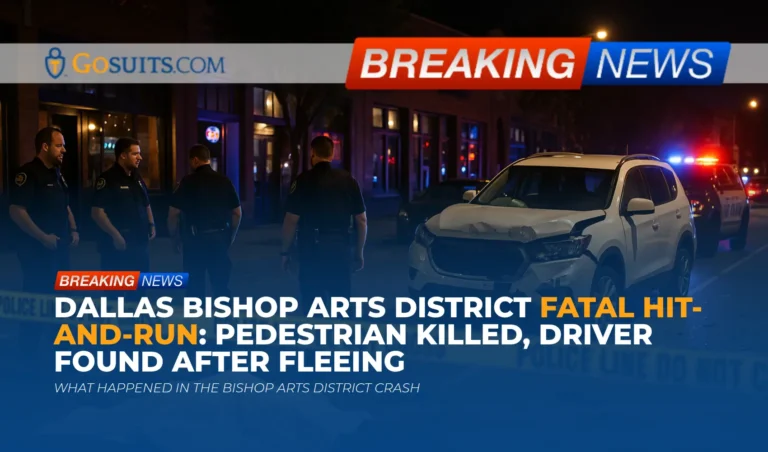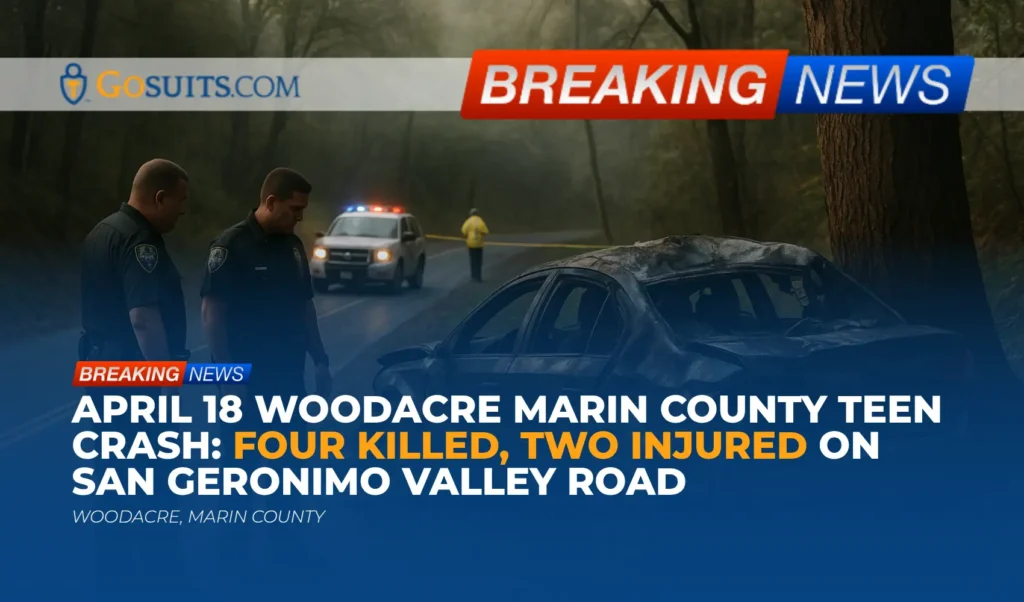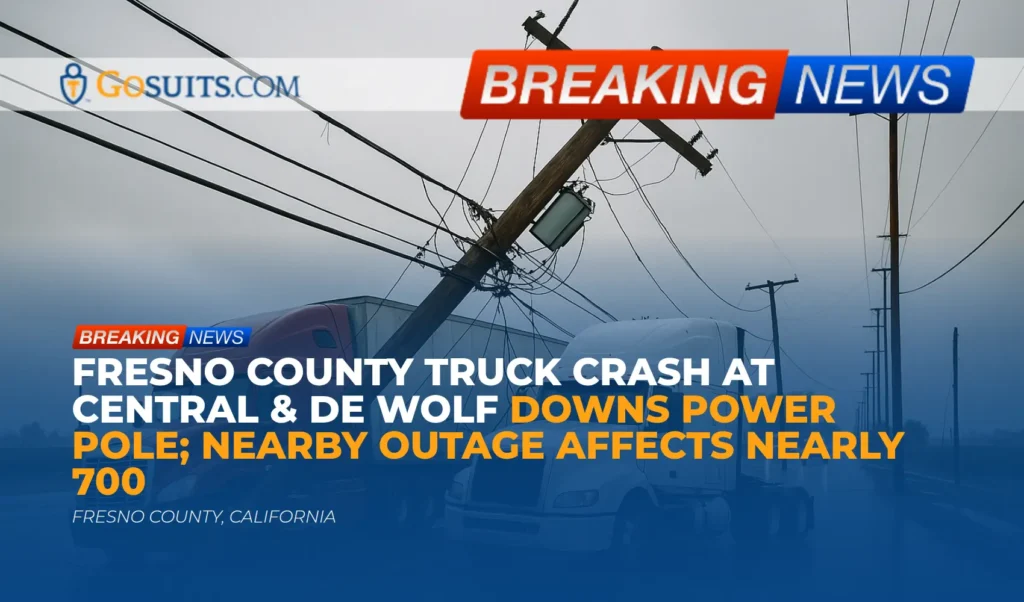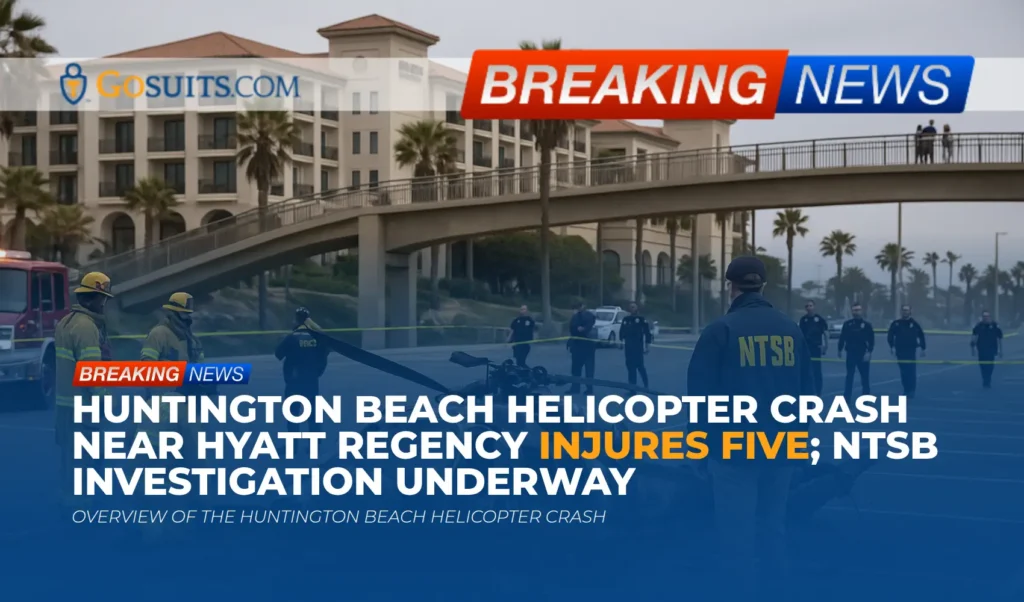- What happened in the Bishop Arts District crash
- Key facts confirmed by authorities
- How a hit and run can affect civil wrongful death claims
- Driver duties and pedestrian safety rules under Texas law
- Evidence families often need and how to find it
- Insurance and financial pathways after a fatal hit and run
- Steps to consider now if pursuing a civil claim in Texas
- Deadlines and timing considerations
- How broader safety data frames this tragedy
- Commentary from Gosuits Dallas, Texas Personal Injury Attorney
- Action steps and why timing matters
- Texas resources that may help
What happened in the Bishop Arts District crash
On Sunday night in the Bishop Arts District, a pedestrian was struck and killed by a white SUV on the 400 block of West Davis Street. According to information provided by Dallas police at the scene and subsequent reporting, the driver left the scene on foot and was found about an hour later roughly a mile away. First responders pronounced the pedestrian deceased at the scene.
This incident is heartbreaking for family, friends, and the local community, and it raises important questions about accountability, civil remedies, and what practical steps are available to those affected. The information below is offered in a compassionate, plain-language format to help people understand what typically happens next and where critical records can be obtained.
Key facts confirmed by authorities
Time and location
Police were called around 10:30 p.m. to the 400 block of West Davis Street in the Bishop Arts District of Dallas.
People involved
The pedestrian who died has been identified as a 29-year-old man. Friends told officers he had parked and was crossing to meet them at a nearby taqueria when the collision occurred. The driver is reported to be a 29-year-old man who left the crash scene on foot and was located by patrol officers about an hour later.
Condition of the vehicles and scene
Video and photos from the location show a white SUV with severe front-end damage and debris across the roadway. The SUV also reportedly collided with a parked vehicle during the incident.
Law enforcement actions
Officers located the driver approximately a mile from the site and took him for medical clearance before transporting him to jail. While criminal processes may continue separately, the existence of a police investigation and crash documentation is also highly relevant for a civil wrongful death claim.
Community statements
Friends and loved ones expressed grief and a desire for accountability. Those statements often become part of a fuller picture of the decedent’s life and the loss suffered by surviving family members, which can matter in a civil case when establishing damages.
How a hit and run can affect civil wrongful death claims
A fatal crash caused by a driver who flees the scene can carry significant consequences in civil court. While every case depends on its specific facts, several legal concepts typically arise in Texas wrongful death and survival actions.
Wrongful death and survival claims in Texas
Texas law allows certain family members to bring a wrongful death claim for the loss of a loved one’s life. Those eligible generally include the spouse, children, and parents of the deceased. See the Texas Wrongful Death Act at Texas Civil Practice and Remedies Code Chapter 71, including who may sue under Section 71.004. Separately, a survival claim allows the decedent’s estate to pursue the decedent’s own claims that existed immediately before death, under Section 71.021.
Negligence and negligence per se
In many pedestrian cases, liability can be based on negligence, which is the failure to use reasonable care. When a driver violates a safety statute designed to protect the public and that violation causes harm, Texas recognizes a doctrine commonly called negligence per se. For example, speeding beyond what is reasonable and prudent given conditions is prohibited by Texas Transportation Code Section 545.351. Leaving the scene of a crash that involves injury or death violates Section 550.021, which requires drivers to stop, remain, and provide aid. Courts may consider these violations when evaluating civil responsibility.
Evidence of fleeing
Evidence that a motorist left the scene can be relevant in a civil case when a judge or jury considers fault and the seriousness of the conduct. In rare cases, facts can meet the standard for exemplary damages, which require a showing such as fraud, malice, or gross negligence under Section 41.003, with gross negligence defined in Section 41.001. Whether conduct rises to that level depends on the evidence and is evaluated case by case.
Driver duties and pedestrian safety rules under Texas law
Texas law places obligations on both drivers and pedestrians. A few provisions commonly referenced in civil pedestrian cases include the following.
Driver’s duty to exercise due care
Drivers must exercise due care to avoid colliding with pedestrians and must give warning by sounding the horn when necessary. See Texas Transportation Code Section 552.008.
Speed and control
A driver must not operate at a speed greater than is reasonable and prudent under the circumstances then existing, and must control the speed to avoid collisions. See Section 545.351.
Stopping after a crash
If a crash results in injury or death, a driver must immediately stop, remain at the scene, and comply with statutory duties including providing information and rendering aid. See Section 550.021. This requirement is separate from civil liability but can be highly relevant to a civil suit.
Evidence families often need and how to find it
Successful civil claims typically rely on timely gathering of documents and media. The following sources are typically important in a Texas pedestrian fatality case.

Official Texas crash report
Investigating agencies complete a Texas Peace Officer’s Crash Report (CR‑3). Eligible parties can purchase the report once it is submitted to the state. The Texas Department of Transportation explains how crash reports are handled at TxDOT’s crash reports page.
911 recordings, body-worn camera video, and incident records
Public records in Texas can be requested under the Texas Public Information Act. The Attorney General’s Office provides guidance on how to request records from local agencies at How to request public information. Requests to the city police department can encompass CAD logs, 911 audio, body-worn camera video, offense and incident reports, and supplemental narratives. Some materials may be exempt or redacted under applicable law, but timely requests can help preserve access.
Autopsy and death records
In counties with a medical examiner system, autopsies and inquests are governed by the Texas Code of Criminal Procedure Chapter 49. Certified death certificates and verifications are available through the Texas Department of State Health Services at DSHS Vital Records. These documents are often needed for probate, insurance, and civil claims.
Surveillance video and third-party footage
Businesses and residences near the scene may have cameras that recorded the crash or the moments before and after. Video is frequently overwritten quickly. Preservation letters should be sent as soon as possible to nearby establishments to request they retain any relevant footage.
Vehicle data and physical inspection
Modern vehicles may store speed, braking, and throttle data in an event data recorder. Preserving the at-fault vehicle for inspection can be critical. Photographs of damage patterns, roadway gouges, debris fields, and lighting conditions also matter in a reconstruction.
Witness statements
Witness accounts help establish where the pedestrian was, the vehicle’s speed, and the timing of events. Identifying and contacting witnesses promptly helps prevent the loss of memory and ensures accurate statements.
Insurance and financial pathways after a fatal hit and run
Civil recovery in Texas often involves multiple insurance avenues. The availability and order of these sources depend on the policies and facts involved.
At-fault driver’s liability insurance
The primary civil avenue is a claim against the at-fault driver’s liability insurance. This process typically includes investigating the facts, establishing negligence, and documenting damages such as lost income to statutory beneficiaries, mental anguish, loss of companionship, and expenses.
Uninsured and underinsured motorist coverage
If a driver flees or carries inadequate coverage, uninsured or underinsured motorist coverage on the decedent’s household policies may apply. The Texas Department of Insurance describes auto coverages, including uninsured and underinsured options, at TDI’s consumer auto insurance page. Policy language varies, and some coverages require prompt notice or proof of a hit and run. It is wise to review policy documents and timelines carefully before any recorded statements are given.
Crime Victims’ Compensation
Texas operates a Crime Victims’ Compensation Program that may help with certain out-of-pocket costs related to violent crime. Information is available at the Office of the Attorney General’s page here: Crime Victims’ Compensation Program. This is separate from insurance or civil claims and has its own eligibility requirements and deadlines.
Important caution about talking to insurers
Insurance carriers often request recorded statements quickly. What is said to an insurer can be used later and can affect coverage decisions and claim valuation. It is generally prudent to speak with a seasoned and skilled attorney first to understand rights and obligations before giving any recorded statement.
Steps to consider now if pursuing a civil claim in Texas
The following steps are general in nature and can help protect the ability to bring a civil claim. They are not case-specific directions.
- Consult a qualified attorney before speaking with insurers. Early counsel can guide communications, preserve evidence, and address deadlines. Statements to insurers can be used later.
- Request the official crash report. Once available through TxDOT, obtain the CR‑3 report and any supplemental reports.
- Submit timely public information requests. Ask the city police department for 911 audio, CAD logs, body-worn camera footage, incident reports, and any available scene photographs, using the Texas Public Information Act process described by the Attorney General.
- Identify and preserve video evidence. Send preservation notices to nearby businesses and residences. Follow up promptly because footage is often overwritten.
- Collect and safeguard documents. Keep medical and funeral invoices, proof of income for the decedent, tax returns, employment records, and any messages or social media that reflect the decedent’s role in the family.
- Obtain death records. Request certified death certificates from DSHS. If an autopsy was performed, ask about the availability of the report through the medical examiner’s office in accordance with Chapter 49.
- Secure vehicle access. If the involved vehicles are available, discuss inspection and data download with counsel. Avoid authorizing any repairs or disposal that could alter evidence without legal guidance.
- Document the scene and memorials. Take photos of skid marks, debris patterns, lighting, and any memorials that reflect community awareness of the location’s hazards.
Deadlines and timing considerations
Civil claims are governed by statutes of limitations. In Texas, a two-year period generally applies to wrongful death and survival claims. See Texas Civil Practice and Remedies Code Section 16.003. There can be exceptions that shorten or lengthen time, but those are specific to circumstances and are not assumed here. Preserving evidence early is also critical because video may be overwritten and witnesses’ memories can fade.
Insurance policies may contain prompt-notice requirements or cooperation clauses, and some benefits, such as funeral expense coverage or personal injury protection, may have time-sensitive documentation requirements. Because statements to insurance can impact a claim, speak with an attorney first to understand obligations and protections.

How broader safety data frames this tragedy
Pedestrian fatalities have risen in recent years nationally, especially during evening hours and on urban corridors with mixed traffic and nightlife. National Highway Traffic Safety Administration materials discuss the elevated risk pedestrians face and the importance of safe speeds, visibility, and yielding behaviors. See NHTSA’s pedestrian safety resources at NHTSA Pedestrian Safety.
The Centers for Disease Control and Prevention also highlights the public health impact of pedestrian crashes, noting thousands of deaths each year and significant nonfatal injuries. See the CDC’s overview at CDC Pedestrian Safety. While each crash turns on its own facts, these resources help explain why thorough investigations into speed, lighting, driver behavior, and crossing conditions are standard parts of civil case evaluations.
Commentary from Gosuits Dallas, Texas Personal Injury Attorney
Our hearts go out to those grieving in the Bishop Arts community. Losing a loved one suddenly and violently on a familiar street is a loss that ripples through family, friends, and neighbors. The information shared here is intended for general education and to help the public understand typical civil processes after a fatal crash.
Based on the reported facts, investigators will likely focus on speed, visibility, the pedestrian’s path, and the driver’s decision to leave the scene. In civil court, a pattern of unsafe driving and failure to stop can weigh heavily when establishing responsibility. Timely collection of the crash report, scene video, and witness statements is essential to preserve an accurate record of what happened.
In our experience, insurance companies and large entities often move quickly to protect their interests. They may seek recorded statements, request broad medical authorizations, or frame the narrative in ways that shift focus away from driver conduct. People unfamiliar with these processes can feel pressured to talk or sign documents before understanding the legal and financial consequences. Taking the time to consult with a seasoned and skilled attorney first can help level the playing field and ensure that rights are protected.
Free consultations are important because they allow a careful review of potential claims, insurance coverages, and deadlines without upfront cost. Early guidance can help organize evidence requests, preserve video, coordinate with authorities for records, and avoid common pitfalls in speaking with insurers.
Action steps and why timing matters
- Prioritize preservation of evidence. Ask nearby businesses to retain video. Request the official crash report once available through TxDOT. Seek 911 audio and body-worn camera video using the Public Information Act process. Acting within days can prevent permanent loss of key proof.
- Secure critical records. Obtain certified death certificates from the state health department. Inquire about the autopsy and investigative reports through the medical examiner process provided by Chapter 49. These documents are routinely needed for insurance and court filings.
- Organize financial documentation. Gather proof of income, benefits, and household contributions to help quantify the loss. Accurate records support fair evaluation of damages.
- Avoid premature insurance statements. Recorded statements and broad releases can affect coverage and valuation. Consulting counsel first helps ensure rights are not compromised.
- Calendar key dates. Track the two-year limitations period in Texas for wrongful death and survival claims, along with any policy-specific notice deadlines. Timely action protects the ability to pursue a civil case.
Why now matters. Video systems overwrite quickly, scene conditions change, and witnesses become harder to locate. Early, careful steps can preserve the truth of what happened and support a thorough civil evaluation.
Texas resources that may help
- Texas Peace Officer’s Crash Report. Information about crash reports is available from the Texas Department of Transportation at TxDOT Crash Reports. Eligible parties may purchase a CR‑3 after submission by law enforcement.
- Public records requests. Guidance for requesting public information from local agencies is provided by the Texas Attorney General at How to request public information.
- Autopsy and inquest framework. Rules for medical examiners and inquests are in the Texas Code of Criminal Procedure Chapter 49 at Chapter 49.
- Death certificates. Certified death certificates and verifications are handled by the Texas Department of State Health Services at DSHS Vital Records.
- Insurance basics and UM/UIM coverage. Consumer information from the Texas Department of Insurance is at Auto insurance resources.
- Crime Victims’ Compensation. The Texas Office of the Attorney General provides program details at Crime Victims’ Compensation.
- Pedestrian safety background. National Highway Traffic Safety Administration guidance at NHTSA Pedestrian Safety and CDC data at CDC Pedestrian Safety.
- Key Texas statutes often relevant in civil cases. Duties after a crash, Transp. Code 550.021. Duty to exercise due care around pedestrians, Transp. Code 552.008. Reasonable and prudent speed, Transp. Code 545.351. Wrongful death and survival, Civ. Prac. & Rem. Code Chapter 71. Limitations, Civ. Prac. & Rem. Code 16.003. Exemplary damages standards, Civ. Prac. & Rem. Code 41.003.






